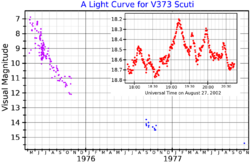Astronomy:V373 Scuti
| Observation data Equinox J2000.0]] (ICRS) | |
|---|---|
| Constellation | Scutum |
| Right ascension | 18h 55m 26.71s[1] |
| Declination | −07° 43′ 05.5″[1] |
| Apparent magnitude (V) | 7.1[2] (Max) – 18.7[3] |
| Details | |
| Mass | 1.02[4] M☉ |
| Rotation | 258.3 s[5] |
| Other designations | |
V373 Sct, AAVSO 1850-07, NOVA Sct 1975[6] | |
| Database references | |
| SIMBAD | data |
V373 Scuti was a nova which appeared in 1975 in the southern constellation of Scutum.[3] It was announced on June 15, 1975 by Paul Wild at the Zimmerwald Observatory, Switzerland.[7] At the time the magnitude was about 7.9.[8] The peak magnitude of 7.1 occurred a month earlier on May 11.[2]
The light curve of this nova declined as a typical power law following the peak, but showed significant jittery behavior.[10] After about 40–50 days emission lines began to appear in the spectrum, which allowed measurement of the mean expansion velocity as 955±130 km/s.[8] The large amplitude flickering as well as other indicators suggest a magnetic influence, making this a candidate intermediate polar system. A luminosity modulation of 258.3 seconds is most likely due to rotation of the white dwarf.[5] The system has an orbital period of 3.69 ± 0.07 h,[3] and the light curve suggests a high orbital inclination.[5]
References
- ↑ 1.0 1.1 Downes, Ronald A. et al. (June 2001), "A Catalog and Atlas of Cataclysmic Variables: The Living Edition", The Publications of the Astronomical Society of the Pacific 113 (784): 764–768, doi:10.1086/320802, Bibcode: 2001PASP..113..764D
- ↑ 2.0 2.1 Duerbeck, Hilmar W. (March 1987), "A Reference Catalogue and Atlas of Galactic Novae", Space Science Reviews 45 (1–2): 1–14, doi:10.1007/BF00187826, Bibcode: 1987SSRv...45....1D
- ↑ 3.0 3.1 3.2 Tappert, C. et al. (December 2013), "Life after eruption - III. Orbital periods of the old novae V365 Car, AR Cir, V972 Oph, HS Pup, V909 Sgr, V373 Sct and CN Vel", Monthly Notices of the Royal Astronomical Society 436 (3): 2412–2425, doi:10.1093/mnras/stt1747, Bibcode: 2013MNRAS.436.2412T
- ↑ Shara, Michael M. et al. (June 2018), "The Masses and Accretion Rates of White Dwarfs in Classical and Recurrent Novae", The Astrophysical Journal 860 (2): 11, doi:10.3847/1538-4357/aabfbd, 110, Bibcode: 2018ApJ...860..110S
- ↑ 5.0 5.1 5.2 5.3 Woudt, Patrick A.; Warner, Brian (April 2003), "High-speed photometry of faint cataclysmic variables - III. V842 Cen, BY Cir, DD Cir, TV Crv, V655 CrA, CP Cru, V794 Oph, V992 Sco, EU Sct and V373 Sct", Monthly Notices of the Royal Astronomical Society 340 (3): 1011–1019, doi:10.1046/j.1365-8711.2003.06367.x, Bibcode: 2003MNRAS.340.1011W
- ↑ "V373 Sct". SIMBAD. Centre de données astronomiques de Strasbourg. http://simbad.u-strasbg.fr/simbad/sim-basic?Ident=V373+Sct.
- ↑ Wild, P. (June 1975), Gingerich, O., ed., "Probable Nova in Scutum", IAU Circular 2791: 1, Bibcode: 1975IAUC.2791....1W
- ↑ 8.0 8.1 8.2 Rosino, L. (May 1978), "Spectral evolution of Nova V400 Per (1974) and Nova V373 Sct (1975)", Astrophysics and Space Science 55 (2): 383–394, doi:10.1007/BF00642265, Bibcode: 1978Ap&SS..55..383R
- ↑ "Download Data". AAVSO. https://www.aavso.org/data-download.
- ↑ Strope, Richard J. et al. (July 2010), "Catalog of 93 Nova Light Curves: Classification and Properties", The Astronomical Journal 140 (1): 34–62, doi:10.1088/0004-6256/140/1/34, Bibcode: 2010AJ....140...34S
External links
- "富山市科学博物館 Toyama Science Museum". tsm.toyama.toyama.jp. http://www.tsm.toyama.toyama.jp/curators/aroom/var/nova/1970.htm.
 |



